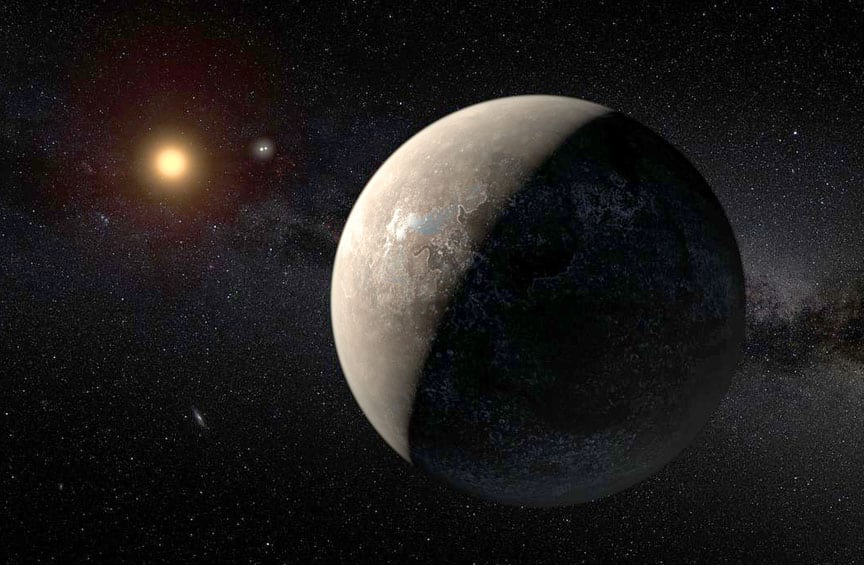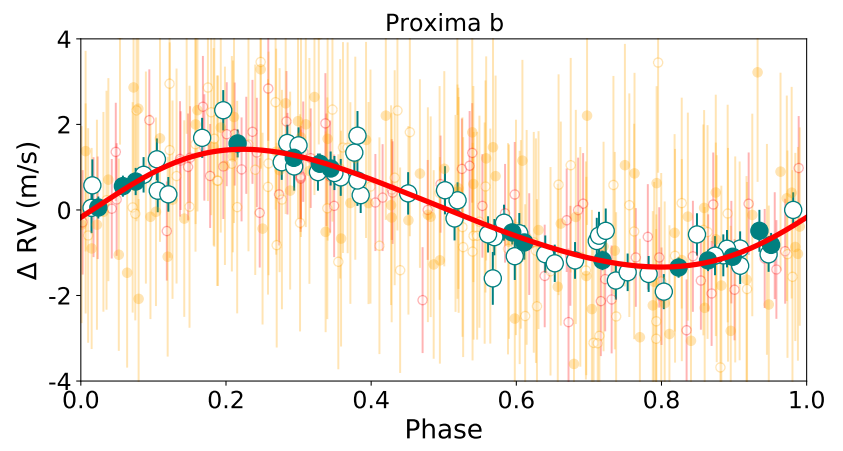ESPRESSO finds Proxima b

Back in 2016, the discovery1 of an exoplanet orbiting Proxima Centauri was a groundbreaking result. Proxima is the closest star to the Sun, at a distance of only 1.3 parsec, or 4.2 light-years from us. And Proxima b, the planet, has a similar mass to that of the Earth, and orbits close to the habitable zone.
Now, the new ESPRESSO instrument2 was able to independently confirm the presence of this planet and measure its mass with higher precision. ESPRESSO is a new spectrograph installed at ESO’s Very Large Telescope (VLT), in the Paranal observatory. It can measure radial velocities with an unprecedented precision, which allows to find very low mass planets, just like Proxima b.
Very soon, the instruments at the ELT will be able to look at Proxima b with new eyes, characterizing the atmosphere of the potentially habitable rocky planet.
See the press pelease from IA — Read the paper on the ArXiv
The star
Astronomers call Proxima Centauri a red dwarf (or M dwarf). Its mass and radius are smaller than the Sun’s, by about a factor of eight. It has a very low luminosity (even though it’s so close) but, like other red dwarfs, its brightness can sometimes increase dramatically because of magnetic activity. It cannot be seen with the naked eye, but it’s there, next to α Cen A and B, the other two members of a triple system.
The planet
The planet discovered around Proxima was called Proxima b, because astronomers are incredibly inventive when naming things. The planet orbits the star at a distance of roughly 0.05 AU3 (about 7.5 million km) with an orbital period of about 11.2 Earth days. That is, a year on Proxima b takes 11.2 days.
Proxima b is slightly more massive than the Earth (1.3 Earth masses) and we think it is probably a rocky planet like ours. Even though it is much closer to its host star, the temperature of Proxima b is estimated to be within the range where water could exist in liquid form. We say that the planet is in the habitable zone. But that doesn’t mean it is inhabited! That, we don’t know yet.
The challenge of detection
Finding such low mass planets can be quite difficult. First, the amplitude of the radial velocity effect the planet has on the star depends on the planet mass and on the orbital period. More massive planets, like Jupiter and Saturn, create radial velocity signals 100 times larger than lighter planets like the Earth and Venus, even though they are much further away from the Sun. So it’s easier to detect more massive planets orbiting closer to their host stars.
Proxima b is fairly close to its star, but it has a low mass. So, how could we detect it?
The answer is that the star is much less massive than the Sun. This means that the planet, even with a mass close to that of the Earth, is able to “push” and “pull” the star harder, resulting in a larger amplitude radial velocity signal.
Instead of the planet orbiting around the star, in reality both bodies actually orbit the center of mass of the system. This means the star is moving back and forth, towards and away from us. We observe a blueshift and a redshift of the stellar light, by looking at its spectrum. If these variations are periodic, we infer the presence of a planetary companion. This is the essence of the radial velocity method.
One additional source of difficulties is the magnetic activity of the star. As it rotates, every 83 days, big star spots at the stellar surface produce an extra modulation in the observed radial velocities. Sometimes, this modulation can be much larger than the signals caused by the planets. So we need to find ways to correct for stellar activity if we want to find the lowest mass planets.
In this new study on Proxima b, we used something called Gaussian processes (GP), a statistical tool that can model very well the activity-induced radial velocity variations. I’ve been working on Gaussian process models for a few years, but it’s still very nice to see how much they can help us. In the figure below, you can see the GP model together with the ESPRESSO radial velocities. All these variations are caused by the star itself. The signal from the planet sits on top of this activity signal.

But the new ESPRESSO observations are much more impressive when compared with previous data from other instruments. Proxima b was first detected using HARPS, another ESO instrument, situated in the La Silla observatory. HARPS used to be the most precise planet-hunting spectrograph, allowing for the discovery of hundreds of exoplanets. It is a truly impressive feat of engineering and human endeavour that ESPRESSO can now achieve much better radial velocity precision.
In the figure below, you can compare the ESPRESSO observations (in green) with the previous HARPS observations (in orange). The improvement is absolutely staggering!

For some context: ESPRESSO is now measuring the radial velocity of Proxima with a precision of 30 cm/s. This is about the same speed as a Galapagos tortoise can move. What this means is that we are able to measure the velocity of a star, about 40 trillion kilometers away from us, with a precision similar to the speed of a giant tortoise!
The future
This is only the first planet confirmed by ESPRESSO. We are currently observing other stars, some like Proxima and others more akin to the Sun. I wouldn’t be surprised if, in a few months, I’m writing here to announce the discovery of an Earth-like planet in the habitable zone of a Sun-like star. Exciting times ahead!